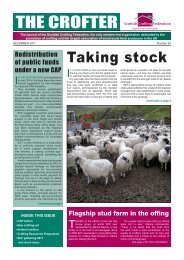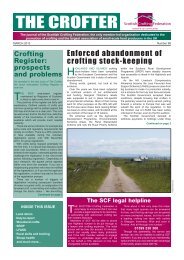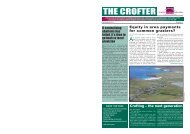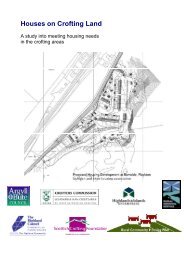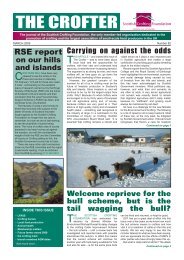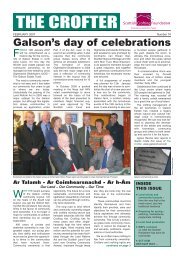THE CROFTER - Scottish Crofting Federation
THE CROFTER - Scottish Crofting Federation
THE CROFTER - Scottish Crofting Federation
Create successful ePaper yourself
Turn your PDF publications into a flip-book with our unique Google optimized e-Paper software.
18<br />
renewable energy<br />
Allt Duisdale reservoir<br />
T<br />
he community of Camuscross<br />
and Duisdale in south Skye will soon<br />
become the proud owners of Allt<br />
Duisdale reservoir, only the eighth community<br />
in Scotland to purchase land under the Land<br />
Reform (Scotland) Act.<br />
They plan to develop the reservoir as a<br />
micro-hydro scheme and hope to work with<br />
the local grazings committee to find a site for<br />
the generator shed.<br />
The project started in February 2009 when<br />
Camuscross and Duisdale Initiative (CDI)<br />
became aware that the small, redundant<br />
<strong>Scottish</strong> Water reservoir had been offered for<br />
sale by auction in Glasgow. With only thirteen<br />
days to go, they immediately contacted the<br />
community assets branch of the <strong>Scottish</strong><br />
government to see if they could use the Land<br />
Reform Act to stop the asset from being sold on<br />
the open market. Working with Sleat Community<br />
Trust, they successfully persuaded <strong>Scottish</strong><br />
Water to withdraw the reservoir from auction,<br />
which gave CDI time to put in a “registration of<br />
interest in land” under the land reform act.<br />
The registration of interest in land process<br />
is not one which community companies can<br />
enter lightly – the initial complicated application<br />
form was just the start of the process. Once the<br />
application had been accepted by the <strong>Scottish</strong><br />
government, there were a number of other<br />
procedures to get through, all with very strict<br />
deadlines. At any of these hurdles, the project<br />
could have been stopped in its tracks.<br />
It was only when CDI received the letter from<br />
Awards for All in February 2010, to say that the<br />
application for £6,457 to purchase the reservoir<br />
had been successful, that the community<br />
company knew that all the months of hard<br />
work had paid off. HIE’s Community Land<br />
Unit is also assisting the project by funding the<br />
conveyancing costs of the purchase.<br />
Once the reservoir is in community<br />
ownership, the next step will be to conduct<br />
a more detailed study into the design, plan<br />
and economics of the hydro scheme, prior to<br />
getting the funding to develop the project; and<br />
begin to implement a biodiversity plan for the<br />
reservoir and small strip of land around it.<br />
CDI hopes to use the existence of the rights<br />
given to crofting communities under the Land<br />
Reform Act to negotiate the purchase of land from<br />
the landlord for the generator shed for the hydro<br />
scheme. Although most people know about the<br />
large community buy-outs, such as those in the<br />
Western Isles which have been made possible<br />
because of the existence of this legislation, the<br />
possibility of using the act to negotiate purchase<br />
of small pieces of land, currently under crofting<br />
tenure, for example for renewable energy projects,<br />
seems to have been little explored.<br />
The community company has an excellent<br />
relationship with Camuscross grazings<br />
committee, whose forward-thinking attitude<br />
means that CDI is able to consider a number<br />
<strong>THE</strong> <strong>CROFTER</strong>, MAY 2010<br />
Student group visit<br />
of partnership projects involving common<br />
grazings land – including affordable house<br />
sites, footpaths and heritage projects. The<br />
aim is that these projects will bring both wide<br />
community benefit and also some revenue for<br />
the grazings committee to reinvest in crofting<br />
activities and infrastructure. The grazings<br />
committee is particularly to be commended<br />
for being willing to consider releasing land for<br />
community projects, as it has one of the tiniest<br />
hill grazings around – with only approximately<br />
350 acres and 37 shareholders!<br />
As the number of community companies<br />
and trusts grows each year, there are many<br />
exciting possibilities in the crofting counties<br />
for community trusts to work actively with<br />
crofters and grazings committees on projects<br />
which could bring both agricultural and<br />
wider community benefit. Perhaps just as<br />
importantly, such joint projects have the<br />
potential to increase goodwill towards crofters<br />
and increase the value and status placed on<br />
the crofting system by the community.<br />
Our thanks to Susan Walker for this report<br />
One of many visits to Allt Duisdale Reservoir - L to<br />
R, Yvonne Davidson and Colin Grey (Community<br />
Assets branch of the <strong>Scottish</strong> Government), CDI<br />
directors Graeme MacKenzie, Nicola Thomson<br />
and Donnie MacKinnon<br />
Controlling ticks<br />
T<br />
icks and the diseases they can<br />
transmit result in serious economic<br />
loss to upland livestock farmers,<br />
sporting estates and are increasingly<br />
perceived as a public health concern.<br />
In the UK the main<br />
diseases that can be<br />
transmitted by ticks are<br />
tick-borne fever (affecting<br />
sheep and cattle),<br />
Lyme disease (affecting<br />
humans, dogs and horses),<br />
louping-ill (affecting all<br />
livestock, humans and red<br />
grouse) and Babesiosis<br />
(affecting cattle).<br />
The Allt Duisdale reservoir dam showing the<br />
volume of water which the community hopes<br />
can be harnessed to generate electricity and<br />
an annual income for commmunity projects<br />
Although there are at least 22 species of tick<br />
in the UK, the sheep tick, (Ixodes ricinus) is of<br />
most concern to livestock farming. Ticks have<br />
a complex three-host life cycle and can feed<br />
off any warm-blooded animal (including man).<br />
However, ticks only suck blood for about 20<br />
days of their three-year life-cycle. Thus most<br />
of the life-cycle of a tick is spent not on the<br />
host but in the environment.<br />
Ticks need a moist environment to survive<br />
when off the host. Ticks will generally not survive<br />
in well-drained lowland pasture. However, they<br />
can flourish on improved pasture if it receives<br />
rainfall throughout the year. Ticks also require<br />
an average daily temperature of 70C to be<br />
active so they are generally inactive during the<br />
Allt Duisdale Reservoir with the hills of<br />
Knoydart in the background.<br />
average UK winter.<br />
Controlling ticks<br />
The control of ticks requires a vigorous<br />
and sustained programme if it is going<br />
to have an impact. Although much of the<br />
tick’s life-cycle is spent away from the host,<br />
control measures to reduce numbers of ticks<br />
off the host are limited. Attempts to use<br />
insecticides by environmental application are<br />
unacceptable, due to the effect on all forms<br />
of insect life. Reducing suitable tick habitat,<br />
such as bracken control and creation of welldrained<br />
improved pasture lacking a moisture<br />
retentive mat does have a role, but only as<br />
part of a more comprehensive strategy.<br />
Current control is therefore largely reliant




